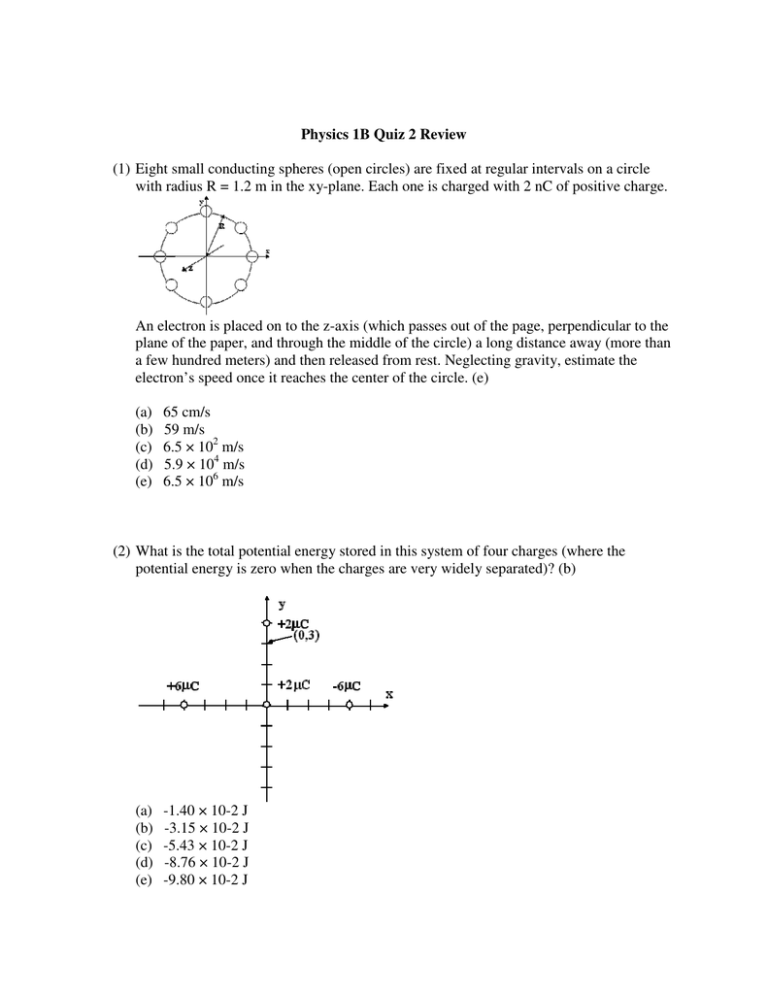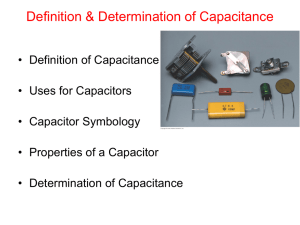Eight small conducting spheres (open circles) are fixed at regular... (1) with radius R = 1.2 m in the xy-plane. Each...
advertisement

Physics 1B Quiz 2 Review (1) Eight small conducting spheres (open circles) are fixed at regular intervals on a circle with radius R = 1.2 m in the xy-plane. Each one is charged with 2 nC of positive charge. An electron is placed on to the z-axis (which passes out of the page, perpendicular to the plane of the paper, and through the middle of the circle) a long distance away (more than a few hundred meters) and then released from rest. Neglecting gravity, estimate the electron’s speed once it reaches the center of the circle. (e) (a) (b) (c) (d) (e) 65 cm/s 59 m/s 6.5 × 102 m/s 5.9 × 104 m/s 6.5 × 106 m/s (2) What is the total potential energy stored in this system of four charges (where the potential energy is zero when the charges are very widely separated)? (b) (a) (b) (c) (d) (e) -1.40 × 10-2 J -3.15 × 10-2 J -5.43 × 10-2 J -8.76 × 10-2 J -9.80 × 10-2 J (3) Two parallel plate capacitors are constructed as shown below. The first has plates with dimension W and L separated by a distance d. The second has plates with dimension W and 2L separated by a distance 2d. Compare the capacitance of the two capacitors. (b) (a) C1 > C2 (b) C1 = C2 (c) C1 < C2 (4) A charge of –5.0 mC is rigidly held on the x-axis at x=4.3 m. Find the work done bringing a – 10.0 mC particle in from infinity to x=4.6 m. (c) a) 9.7 b) 7.5 c) 1.5 b) 3.0 c) 3.0 x 104 J x 105 J x 106 J x 106 J x 108 J (5) There is a charge of 1.0 C on each plate of: (d) a) a 1.0 mF capacitor with a potential difference of 1.0 V across the capacitor. b) a 1.0 F capacitor with a potential difference of 1.0 mV across the capacitor. c) a 1.0 F capacitor with a potential difference of 5.0 mV across the capacitor. d) a 5.0 mF capacitor with a potential difference of 0.20 kV across the capacitor. e) a 5.0 mF capacitor with a potential difference of 5.0 mV across the capacitor. The next two problems refer to the same diagram. (6) The magnitude of the net electric potential at P is (a) a. 6.4 x 1010 V b. 4.5 x 1010 V c. 3.2 x 1010 V d. 2.2 x 1010 V e. 0 (7) The direction of the electric potential at P is: (e) a. b. c. d. e. in the direction of the positive y-axis. in the direction of the negative y-axis. in the direction 45° below the positive x-axis. in the direction 45° below the negative x-axis. there will be no direction associated with electric potential. (8) Four capacitors are connected as shown below. What is the equivalent capacitance between points a and b? (b) a) 3/4 µF b) 10/9 µF c) 4/3 µF d) 3 µF e) 6 µF (9) Given the configuration of charges shown at right, what is the work done by the electric force to bring a charge of –q from infinitely far away to point X? Here q = 1.2 µC and the square has sides of length 2 cm. (a) (a) (b) (c) (d) (e) +0.838 J +0.350 J 0 -0.350 J -0.838 J (1) A charge of +10 kC is located at x=0.0 m. A positive test charge is located at x=1.0 m. If the test charge is then moved to x=3.0 m, the electric potential of the test charge (a) a) decreases by a factor of 3. b) increases by a factor of 3. c) decreases by a factor of 9. d) increases by a factor of 9. e) increases by a factor of 2. (2) A uniform electric field is set up between the two parallel plates of a capacitor at a potential difference of 200 V. The distance between the two plates is 0.5 cm. What is the magnitude of the electric field between the two plates?(a) \ (a) 4 × 104 N/C (b) 2 × 104 N/C (c) 8 × 103 N/C (d) 4 × 103 N/C (e) 1.6 × 103 N/C (3) Calculate the charge Q1, on the positive plate of capacitor C1. (b) (a) (b) (c) (d) (e) Q1 = 29.2 µC Q1 = 41.4 µC Q1 = 52.4 µC Q1 = 61.0 µC Q1 = 73.8 µC (4) Given are 4 charges on a square of side a = 25 cm (see figure below) and q = 1 µC. What is the electric potential V at the center of the square? (b) (a) (b) (c) (d) (e) V = -288,000 V V = -51,000 V V=0V V = 51,000 V V = 288,000 V (5) Two otherwise identical parallel plate capacitors, with area A = 1 m2 and plate separation d = 1 cm are charged to a voltage VB = 1 V. In the first capacitor the plates are separated by empty space. In the second capacitor a dielectric with κ = 2 completely fills the volume between the plates. The energy and charge of the capacitors is PE1 and Q1 for case 1, and PE2 and Q2 for case 2. Which one of the following statements is true? (c) (a) (b) (c) (d) (e) PE1 = PE2 and Q1 = Q2 PE1 = 2PE2 and 2Q1 = Q2 2PE1 = PE2 and 2Q1 = Q2 PE1 = 2PE2 and Q1 = 2Q2 2PE1 = PE2 and Q1 = 2Q2


![Sample_hold[1]](http://s2.studylib.net/store/data/005360237_1-66a09447be9ffd6ace4f3f67c2fef5c7-300x300.png)





